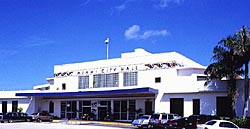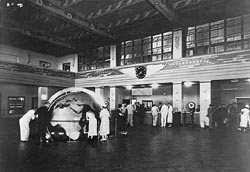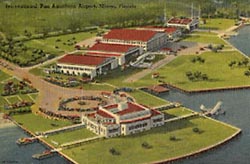
The Pan American Seaplane Base in Coconut Grove, Florida, is important in the history of the aviation industry. Dinner Key was a small island in Biscayne Bay, and was joined to the mainland during World War I to provide a training field for the U.S. Navy. After the war, the base was used by non-scheduled commercial fliers, until the Navy facility was destroyed by the 1926 hurricane. In 1930, a newly formed airline company, known as Pan American Airways (Pan Am), symbolized by eagles and globes, acquired the New York-Rio-Buenos Aires Airline which flew twin-engine Commodore flying boats between Miami and Buenos Aires. The former naval air base at Dinner Key was selected by Pan Am as the base for its inter-American operations with the inaugural flight from Dinner Key to Panama taking place on December 1, 1930. Charles Lindbergh, who was a technical advisor to Pan Am, surveyed some of the early air routes. Because of inadequate landing facilities along the South American route, flying clipper ships were utilized by Pan Am, forming a vital link between North and South America.

Pan American opened the first hangar in 1931. The first passenger "terminal" at the Dinner Key seaplane base was a houseboat obtained in Havana, Cuba, towed by tugs to Miami and anchored to pilings with barges at each end. That same year expansion of the facilities at Dinner Key was undertaken. Additional land was filled in, and a deeper channel, one mile long and 700 feet wide was dredged. The dredging of the channel was a significant event, marking the first time an appropriation was approved by the Congressional Rivers and Harbors Committee "expressly for dredging to create a navigable channel for marine aircraft." The present terminal building and several additional hangars were also constructed during this period of expansion. By 1938, all major structures called for in the plans were completed and operative. During World War II, the Key again served as a base for the U.S. Navy, as well as continuing to serve the needs of international air travelers. With the appearance of landing fields in Latin America came a decrease in the need for seaplanes. Pan Am's final flight to Dinner Key took place August 9, 1945.

The two-story terminal building is rectangular in shape with one-story extensions on each side, white stucco exterior walls and a flat roof. Extending around the building just below the cornice is a frieze of winged globes and rising suns, connected at the corners by sculptured eagles. A restaurant and cocktail lounge originally existed in the building, and takesoffs and landings were observed from an outer promenade on the second floor. At the first-floor level were waiting rooms, an international mail office, customs, public health offices, immigration and ticket counters. A giant, three-and-one-half ton revolving world globe in the lobby once attracted thousands of visitors to the building. In 1946, the City of Miami purchased 39 acres of the Dinner Key site. In 1954, the terminal building was adapted for use as the Miami City Hall. Recent renovations to the building include restoring the original decorative features of the terminal including the beams, wall murals and ceiling, which consisted of panels depicting the signs of the zodiac painted in a modern style. The murals near the ceiling depict the history of flight from Leonardo Da Vinci's designs to the Clipper planes flown by Pan American.
Visit the National Park Service Travel American Aviation to learn more about Aviation related Historic Sites.
Last updated: September 3, 2017
